“For the first time in human history, our contributions in the workplace come more from our minds than from our muscles. The ability to use and create knowledge may now be the single greatest asset in the workplace – an asset that allows people to do something really significant. This age is fraught with both challenges and opportunities. Not the least of these challenges is how to work effectively in the postindustrial era. Smart people and smart organizations will help us meet this challenge.
We have entered the age of the distributed mind.” (Fisher & Fisher, 1998)
In present time this phrase still remains true, we are still in the age of the distributed mind. A 2013 study performed by McKinsey Global Institute touched on 12 technologies that will further “transform life, business, and the global economy” by improving the reach of technology and internet to people today to be able to improve the workforce. The technology that I will be focusing on in this blog is the Automation of Knowledge Work.
The Automation of Knowledge Work
The automation of knowledge work is best described as “retrieving, evaluating, organizing, analyzing, sharing, presenting, applying, securing, and storing information with the goal of making decisions and delivering services… [through] the interaction of technology, information, humans, and organizations.”(Bernstein). The core knowledge work activities are illustrated below.
Some examples of the basic early adopters of the automation of knowledge work include Wikipedia and Youtube.
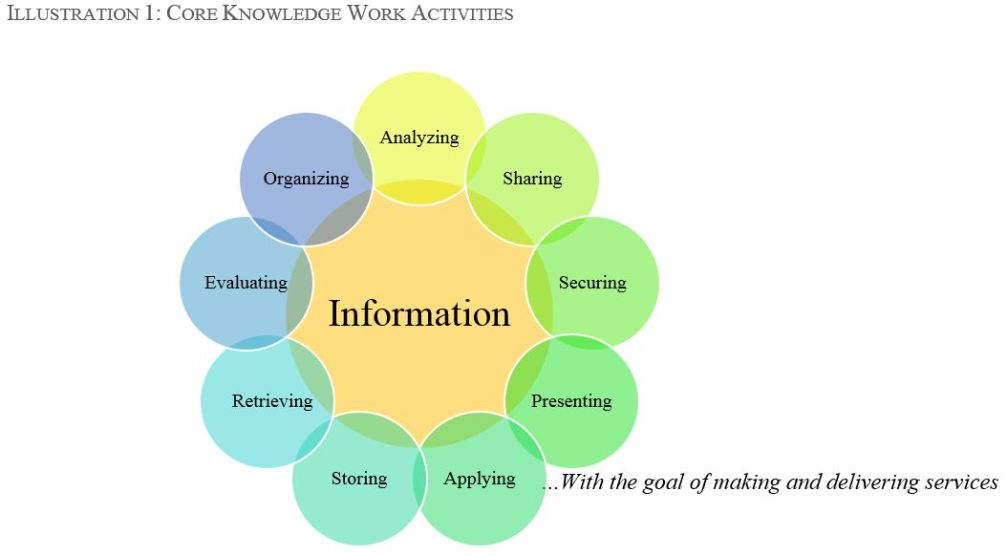 Business Use
Business Use
Currently, the automation of knowledge work has taken many forms for businesses. This includes the demand for Knowledge Workers, Online Talent Marketplaces, and the use of technology to automate tasks.
There is currently a demand for employees called “Knowledge Workers” who are engaged primarily with the core activities of knowledge work (Bernstein). This has impacted the way employers are looking at compensation of workers and the structure of positions of Knowledge Workers. Where the normal position has “time-based pay”, Knowledge Wo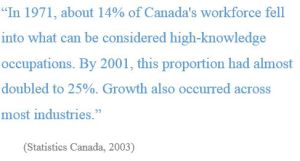 rkers are more likely to get “piece-rate pay” because they get compensated “according to the amount of output they produce, thereby tying pay directly to performance” (Stevenson & Hojati, 2011, p 244). Employers have been forced to take this approach because it is hard to structure the work of the knowledge worker effectively (Davenport, 2011).
rkers are more likely to get “piece-rate pay” because they get compensated “according to the amount of output they produce, thereby tying pay directly to performance” (Stevenson & Hojati, 2011, p 244). Employers have been forced to take this approach because it is hard to structure the work of the knowledge worker effectively (Davenport, 2011).
“IBM is a big believer in virtual organizations enabled by talent clouds. As IBM CEO Ginni Rometty recently put it, “The social network will be the new production line.”” (Mahidhar & Schatsky, 2013). Online talent market places have b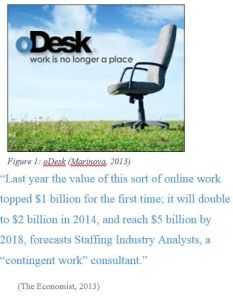 een trending for businesses. Through websites such as Elance, oDesk and Expertbids, businesses have been able to reach freelancers ranging in specialities of marketing, accounting, and they can even find lawyers. These websites “help employers identify workers with needed skills and engage them in project work” (Mahidhar & Schatsky, 2013). This has changed the way businesses look at the location of businesses and the way employers look at remuneration for employees/freelancers. On oDesk an employer can look for a worker by location and talent or just by talent, by being able to do this, employers do not need to put a lot of emphasis on the consideration of office “labour factors” for “regional/country factors” for location of offices (Stevenson & Hojati, 2011, p. 257). Also, with the availability of freelancers/workers bidding on the business projects, the business has a large array of possibilities for remuneration of the worker including flat rate pay and hour rate pay at different rates for each bidder (The Economist, 2013).
een trending for businesses. Through websites such as Elance, oDesk and Expertbids, businesses have been able to reach freelancers ranging in specialities of marketing, accounting, and they can even find lawyers. These websites “help employers identify workers with needed skills and engage them in project work” (Mahidhar & Schatsky, 2013). This has changed the way businesses look at the location of businesses and the way employers look at remuneration for employees/freelancers. On oDesk an employer can look for a worker by location and talent or just by talent, by being able to do this, employers do not need to put a lot of emphasis on the consideration of office “labour factors” for “regional/country factors” for location of offices (Stevenson & Hojati, 2011, p. 257). Also, with the availability of freelancers/workers bidding on the business projects, the business has a large array of possibilities for remuneration of the worker including flat rate pay and hour rate pay at different rates for each bidder (The Economist, 2013).
“A common held misconception is that workers are the main determinant of productivity” (Stevenson & Hojati, 2011, p. 43), by improving the automation of knowledge work businesses have been able to counter the root of the productivi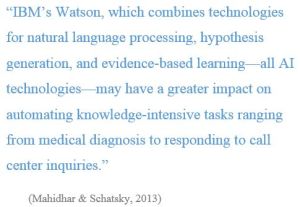 ty problem. Businesses have been using technology to automate tasks such as Siri for the iPhone and automated call center responses. By doing this, businesses have “used [automotive technology] to guide the development of predictive models and analytics” (Mahidhar & Schatsky, 2013), thereby increasing the efficiency of knowledge workers and applications of the information they use.
ty problem. Businesses have been using technology to automate tasks such as Siri for the iPhone and automated call center responses. By doing this, businesses have “used [automotive technology] to guide the development of predictive models and analytics” (Mahidhar & Schatsky, 2013), thereby increasing the efficiency of knowledge workers and applications of the information they use.
Anticipated Future Impacts
“Large depositories of memory, high processing speeds, and sensory perception have allowed computers to perform analyses and solve problems. As innovations continue and these computers become more advanced, they will replace humans for specific jobs.” (Bidness, etc)
With the increased use of knowledge workers and automated technologies, it is likely that may jobs will be taken over by computers such as call center workers, data entry clerks, and analysts. “[W]e estimate 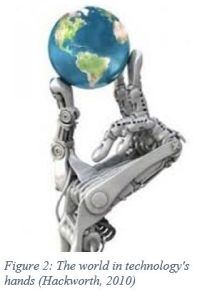 that knowledge work automaton tools and systems could take on tasks that would be equal to the output of 110 million to 140 million full-time equivalents (FTEs)” (Manyika, 2013). One setback to this overwhelming possibility of automation taking away many positions in businesses is the cultural and regulatory hurdles that the automation of knowledge work would have to overcome. “To protect citizens, many knowledge work professions (including legal, medical, and auditing professions) are governed by strict regulatory requirements regarding who may perform certain types of work and the processes they use” (Manyika, 2013).
that knowledge work automaton tools and systems could take on tasks that would be equal to the output of 110 million to 140 million full-time equivalents (FTEs)” (Manyika, 2013). One setback to this overwhelming possibility of automation taking away many positions in businesses is the cultural and regulatory hurdles that the automation of knowledge work would have to overcome. “To protect citizens, many knowledge work professions (including legal, medical, and auditing professions) are governed by strict regulatory requirements regarding who may perform certain types of work and the processes they use” (Manyika, 2013).
Ensuring success during the change
In the article Rethinking Knowledge Work by Mr. Davenport, it outlines two main issues companies need to address to ensure the success of knowledge work in the company. The first issue is to “develop a strategy for knowledge work” (Davenport, 2011), meaning that the structure in which knowledge workers perform their duties needs to be more standardized. This does not mean every knowledge worker would be looking for the same information, but the structure in which they go about doing their work would be more measurable. There are studies available to be able to determine the length of time a knowledge worker should take to perform their job, one I would recommend focusing on is predetermined element times. “To use this approach, [you] must divide the job into its basic elements, measure the distances involved, rate the difficulty of the element, and then refer to the appropriate table of data to obtain the time of that element.” (Stevenson & Hojati, 2011, p. 239). One set back to using predetermined element times is that “it requires a high level of skill” (Stevenson & Hojati, 2011, p. 240), and there are many tables to be referred to, to find the appropriate time.
The second issue is to “pursue IT and productivity opportunities at the right level of granularity.” (Davenport, 2011). “[L]eaders of knowledge workers should understand the key differences among them and tailor solutions to these peculiarities.” (Davenport, 2011). This means that even though you have produced a standardized time of the knowledge workers job, there may be situations in which the standard does not apply. For example, if there is a particularly complex task that involves a large amount of primary external research that has not been performed yet.
Overall, it is important to know how long a knowledge worker task should take, but one must go with stride for every situation that arises.
Exam Question
What is the goal of the automation of knowledge work?
Bibliography
Bernstein, Mark (Presenter). (n.d.). Knowledge Work 2020: The furture if knowledge work and what it might mean to each of you [Power-point]. Retrieved from download.microsoft.com/…/Mark%20Bernstein%20Xerox%20Summit%…
Bidness, etc. (n.d). The Automation Of Knowledge Work: Rise Of The Machines. Retrieved from http://www.bidnessetc.com/business/the-automation-of-knowledge-work-rise-of-the-machines/
Davenport, T. (February, 2011). Rethinking knowledge work: A strategic approach. Retrieved from http://www.mckinsey.com/insights/organization/rethinking_knowledge_work_a_strategic_approach
The Economist. (June 2013). The workforce in the cloud. Retrieved from http://www.economist.com/news/business/21578658-talent-exchanges-web-are-starting-transform-world-work-workforce
Fisher, K., & Fisher, M. D. (1998). The Distributed Mind: Achieving High Performance Through the Collective Intelligence of Knowledge Work Teams. New York: AMACOM.
Hackworth, C. (2010). What does it mean to be a Technological Citizen? Retrieved from http://thetechnologicalcitizen.com/?page_id=2
Mahidhar, V., Schatsky, D. (July 2013). The future of knowledge work. Retrieved from http://dupress.com/articles/the-future-of-knowledge-work/
Manyika, J., et al. (May 2013). Disruptive technologies; Advances that will transform life, business, and the global economy. Retrieved from http://www.mckinsey.com/insights/business_technology/disruptive_technologies
Marinova, D. (April 2013). Why oDesk Is The Best Freelance Jobs Website. Retrieved from http://www.dianamarinova.com/why-odesk-is-the-best-freelance-jobs-website/
oDesk. (2015). Get your job done – on demand. Retrieved from https://www.odesk.com/i/howitworks/client
Statistics Canada. (Oct. 2003). Study: Knowledge workers in Canada’s workforce. Retrieved from http://www.statcan.gc.ca/daily-quotidien/031030/dq031030a-eng.htm
Stevenson, W. J., & Hojati, M. (2011). Operations Management (4th Canadian Edition). McGraw-Hill Ryerson.
